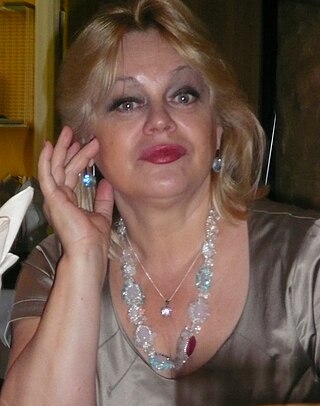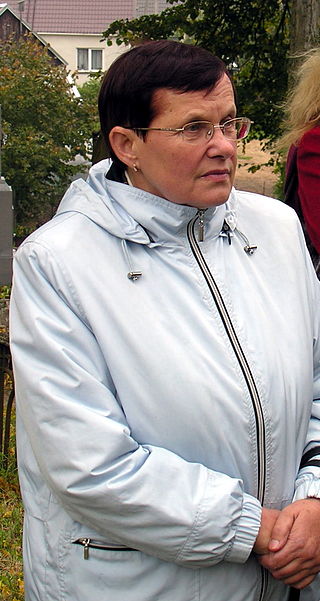
Kaunas is the second-largest city in Lithuania after Vilnius and an important centre of Lithuanian economic, academic, and cultural life. Kaunas was the largest city and the centre of a county in the Duchy of Trakai of the Grand Duchy of Lithuania and Trakai Palatinate since 1413. In the Russian Empire, it was the capital of the Kaunas Governorate from 1843 to 1915.

Antanas Žmuidzinavičius was a Lithuanian painter and art collector.
Irena Trečiokaitė-Žebenkienė was a Soviet and Lithuanian painter.
Bronius Vyšniauskas was a Lithuanian sculptor. He was an Honored Art Worker of the Lithuanian Soviet Socialist Republic (1963), People's Artist of the Lithuanian SSR (1973), and a recipient of the Lithuanian SSR State Prize (1973).
Viktorija Daniliauskaitė is a Lithuanian printmaker, and book illustrator.
Vytautas Janulionis was a Lithuanian glass artist. He was born in Klaipėda.
Vidmantas Jažauskas is a Lithuanian painter, book illustrator, poet, and social activist.
Zita Kreivytė is a Lithuanian fashion designer, and artist.
Česlovas Lukenskas is a Lithuanian sculpture and performance artist.
Vidmantas Jusionis is a Lithuanian painter.

Petras Rimša was one of the first professional Lithuanian sculptors and medalists.

Janina Buzūnaitė-Žukaitienė is a Lithuanian painter, poet, creator of accessories and metal sculptures. She is a member of the Federation of Canadian Artists (FCA) since 2000. Abstract themes are dominant in artist's work and expressionism is felt throughout all paintings. Author's poems are mostly influenced by neo-romanticism and modern rhyming techniques. In regard to fashion accessories, they are massive but with a close attention to the detail – giving a social status.

Viktorija Daujotytė-Pakerienė is a Lithuanian literary critic and philologist. She has written more than 30 scientific monographs, as well as essays and Lithuanian language textbooks for general education and higher education. She has also written about culture, feminism, and society. She was awarded the Lithuanian Grand Duke Gediminas, the fourth degree of the Order of the Lithuanian National Culture and Art, Unity, and National Progress, and other prizes.

Vytenis Jankūnas is a Lithuanian-American artist living and working in New York City. His work consists of photographs, paintings and mixed media works.
Andrius Zakarauskas is a painter from Lithuania.

Grytė Pintukaitė is a Lithuanian portrait painter, member of the Lithuanian Artists' Association, and member of the Association LATGA - Lithuanian Copyright Society.
Vytautas Landsbergis-Žemkalnis was a Lithuanian architect most active in interwar Lithuania (1926–1939). He was the father of Vytautas Landsbergis, the first Lithuanian head of state after independence from the Soviet Union.
Ramybė Park is a public park in Kaunas, Lithuania, established in 1959 in the territory of the Kaunas City Old Cemetery that was also known as the Carmelite Cemetery. The cemetery was established in 1847 and became the main city cemetery with sections for four different religions – Roman Catholics, Eastern Orthodoxs, Lutherans, and Muslims. During World War I and subsequent Lithuanian Wars of Independence, Russian, German, and Lithuanian soldiers were buried in the cemetery. During the interwar period when Kaunas was the temporary capital of Lithuania, many famous people were buried there and several buildings were constructed on the cemetery's territory. In 1930, a monument to fallen Lithuanian soldiers with a tomb of an unknown soldier was unveiled. Around the same time, a tradition to honor fallen soldiers on the All Saints' Day began.

The Lithuanian Art Society was a society that organized Lithuanian art exhibitions and supported Lithuanian artists. Based in Vilnius, it was active from 1907 to the outbreak of World War I in 1914. It was chaired by painter Antanas Žmuidzinavičius. The society was established after the first Lithuanian art exhibition was successfully organized in early 1907. The society continued to organize annual exhibitions that displayed works both by professional and folk artists. Influenced by the Arts and Crafts movement, the society paid great attention to Lithuanian folk art which was increasingly seen as an expression of the Lithuanian character. In 1912, the society published an album of drawings of Lithuanian crosses, column shrines, and roofed poles, which is considered the first study of Lithuanian folk art. The society was also instrumental in preserving the art of Mikalojus Konstantinas Čiurlionis and organized his first solo exhibitions in 1911 and 1913. The society also collected works by other artists and worked with the Lithuanian Scientific Society to establish a Lithuanian art museum. The collection was transferred to the present-day M. K. Čiurlionis National Art Museum in 1920.

Donaldas Kajokas is a poet, essay writer and editor of the Nemunas literary supplement. He studied at the Kaunas Institute of Physical Education and Lithuanian Physical Culture Institute. He sits on the Lithuanian Writers’ Union on the Council of Kaunas Section.








